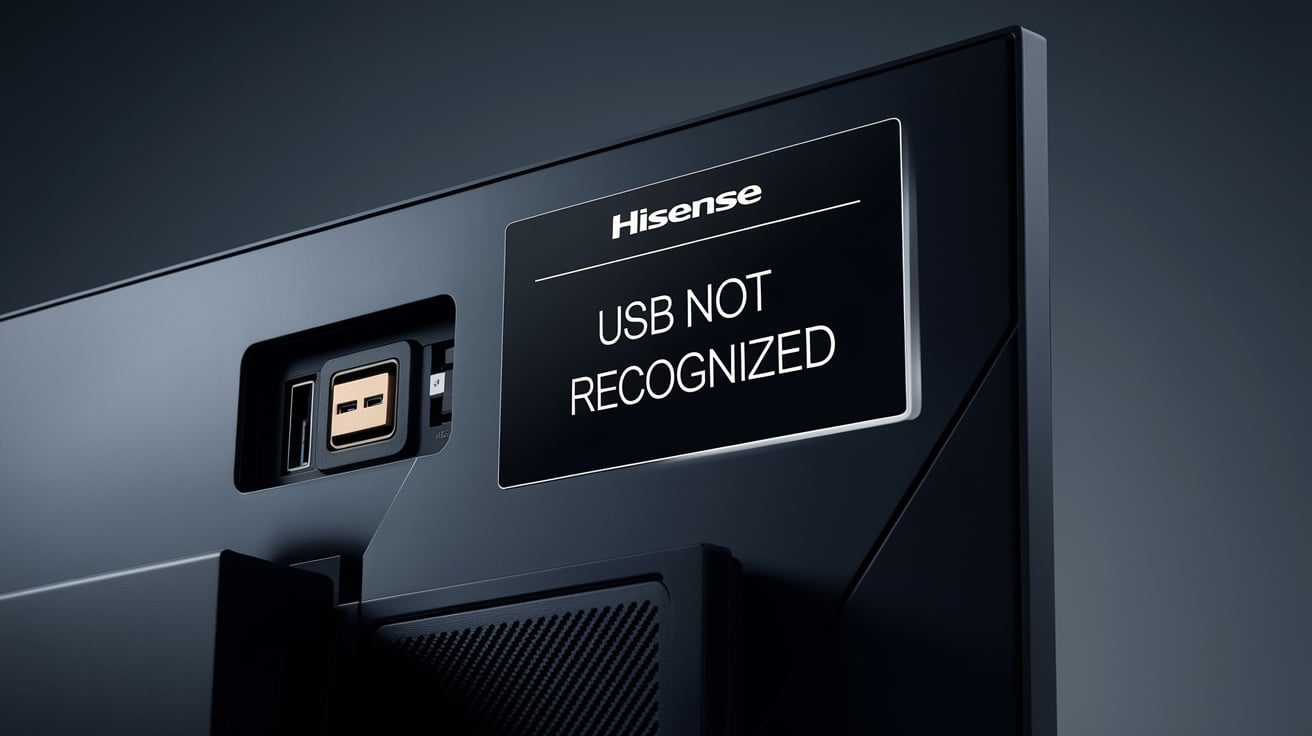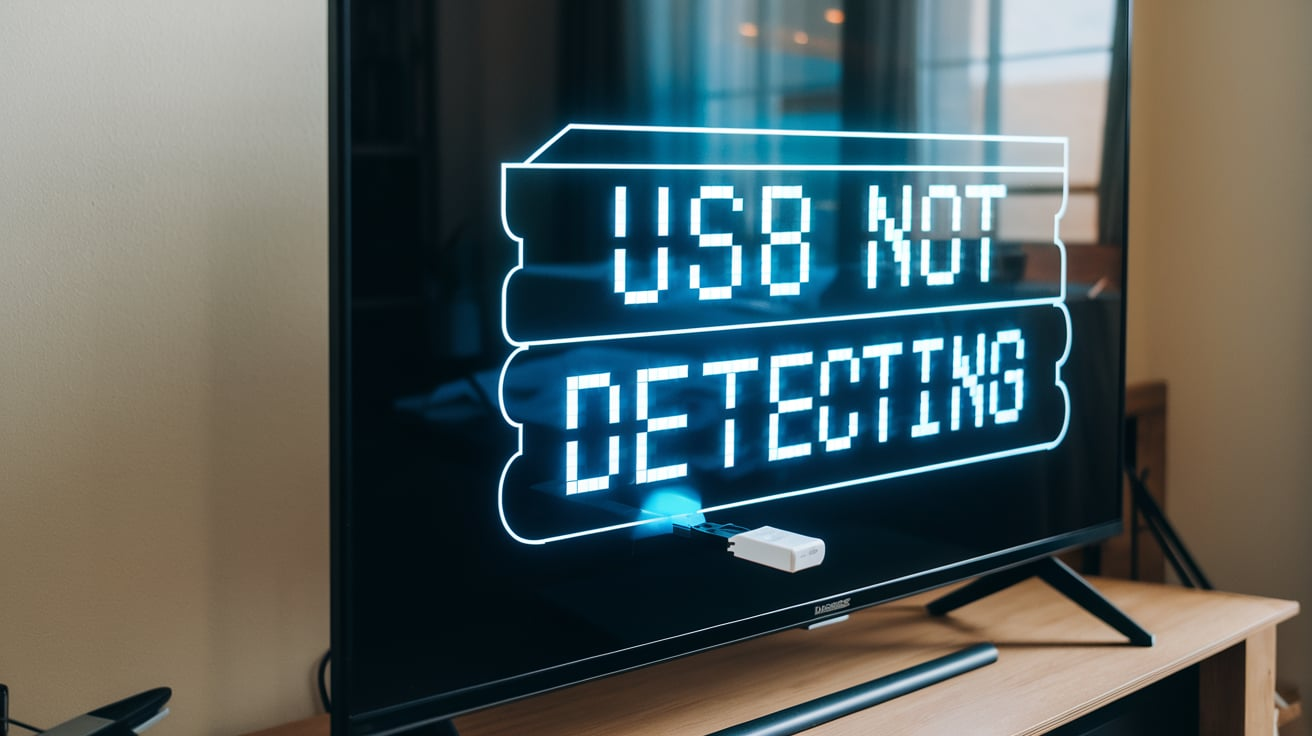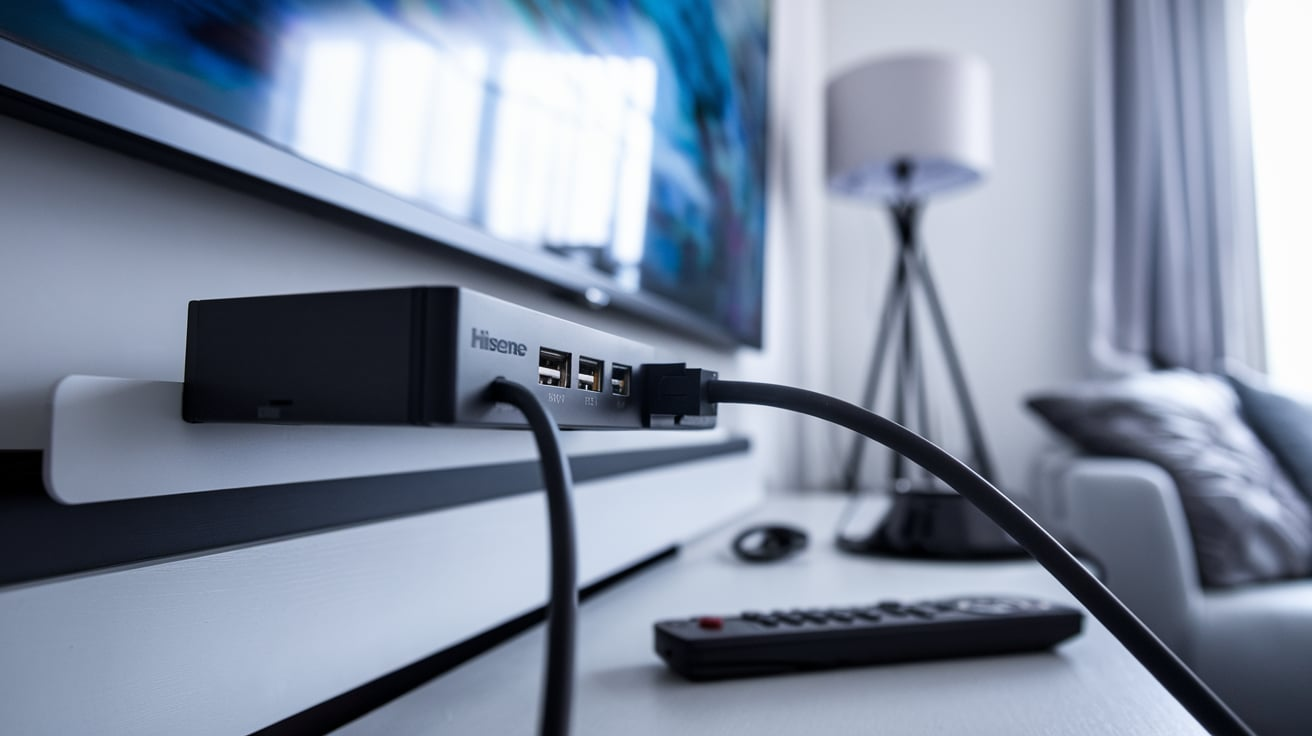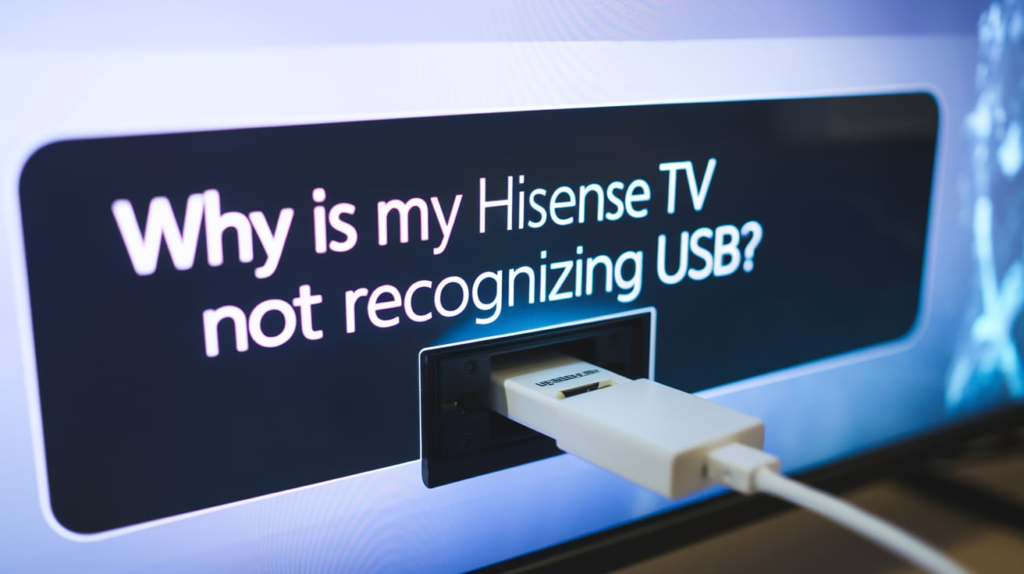If you’ve ever tried to play a movie or music file from a Hisense TV Not Recognizing USB? and found it’s not being recognized, you’re not alone. It’s a frustrating problem that many TV owners encounter. Whether you’re trying to watch media from a flash drive or transfer files to your TV, the last thing you want is to be stuck staring at a “no device detected” message. Thankfully, most of the time, the issue is fixable.There are several reasons why your Hisense TV might not detect a USB drive.

It could be something as simple as the drive not being properly inserted, or perhaps the TV’s USB port has a loose connection. Other times, it’s related to compatibility or file format issues. In some cases, the USB itself could be faulty, or your TV’s software might need an update to support new formats.Before you start troubleshooting, it’s helpful to know what could be causing the issue. In this guide, we’ll walk you through a few key steps to get your Hisense TV back on track. Whether you’re a tech-savvy user or someone just trying to enjoy your favorite content, we’ve got you covered.
How To Fix Hisense TV Not Detecting USB
If your Hisense TV isn’t detecting your USB drive, the first step is to ensure the USB is correctly inserted into the port. Try unplugging and re-plugging it in to make sure it’s properly connected. You can also test the USB in another port, as sometimes a specific port may be faulty. If your TV has multiple USB ports, try using a different one to rule out the possibility of a broken connection.
Next, check the format of the USB drive. Hisense TVs typically support FAT32 or exFAT formats, but they may not recognize NTFS or other file systems. If your USB is not in a supported format, you can reformat it using a computer. Additionally, ensure the drive isn’t damaged and try using a different USB stick if needed. If none of these steps work, consider updating your TV’s software, as an outdated system may cause compatibility issues.
Restart Your Hisense TV
Sometimes, the simplest solution is the most effective. If your Hisense TV isn’t recognizing the USB, a quick restart can often resolve the issue. To restart your TV, power it off completely by unplugging it from the power source for about 30 seconds, then plug it back in and turn it on. This can help refresh the TV’s internal settings and may allow it to detect the USB device properly.
A restart is especially helpful if the TV has been running for a long time or has encountered temporary software glitches. By rebooting, you’re essentially giving the system a fresh start, which can clear up minor issues related to USB recognition.
Format The USB Flash Drive
If restarting your Hisense TV doesn’t resolve the issue, the next step is to check the format of your USB flash drive. Hisense TVs typically support FAT32 and exFAT file systems. If your USB is formatted in NTFS or another incompatible format, it may not be recognized. To fix this, you can easily reformat your USB drive using a computer. Be sure to back up any important data on the drive first, as formatting will erase all files.

To format your USB drive, plug it into a computer, open the file explorer, right-click on the drive, and select the “Format” option. Choose FAT32 (for drives under 32GB) or exFAT (for larger drives) as the file system, and proceed with the formatting process. Once formatted, safely eject the USB and plug it back into your Hisense TV. This should resolve compatibility issues and allow your TV to recognize the drive.
Missing Media Player App
Another reason your Hisense TV might not recognize the USB is if the required media player app is missing or disabled. Most Hisense Smart TVs come with built-in media players that support USB media playback, but sometimes the app may not be installed, or it could be malfunctioning. If the app is missing, you can check the TV’s app store to see if you can reinstall or update the media player app.
To check or install the media player app, go to your TV’s settings menu and navigate to the app section. If the app is disabled, enable it; if it’s missing, you might need to download or update it from the app store. Once the app is active, restart your TV and try connecting the USB drive again. This should allow your TV to detect and play media files from the USB.
Check The USB Connection
Sometimes, a simple connection issue can prevent your Hisense TV from recognizing the USB drive. Start by ensuring that the USB is securely plugged into the TV’s USB port. It might sound obvious, but a loose or partially connected USB can cause detection problems. If possible, try plugging the USB into a different port on the TV to rule out any issues with the specific port you’re using.
If the connection still isn’t working, inspect both the USB drive and the TV’s USB ports for any visible damage or dirt. Dirt, dust, or corrosion on the metal contacts can interfere with the connection. Use a dry cloth or compressed air to clean both the USB port and the drive’s connector, then try reconnecting. This can help restore the connection and allow the TV to recognize the USB device properly.
Test With A Different USB Drive
If your Hisense TV still isn’t recognizing the USB, try testing with a different USB drive. The issue might not be with the TV itself but with the USB drive you’re using. Some USB drives may have compatibility issues, be faulty, or have corrupted data that prevent them from being detected. By swapping out the USB drive with a different one, you can easily determine if the original USB is the problem.
Choose a USB drive that you know works with other devices, and make sure it’s formatted correctly in FAT32 or exFAT. Plug it into the TV and check if it gets recognized. If the second drive works, then the issue likely lies with the first USB drive, which may need reformatting or replacement. If the second USB also doesn’t work, the issue may be with the TV’s USB ports or settings.
Update Hisense TV Firmware
If your Hisense TV isn’t recognizing the USB drive, it could be due to outdated firmware. TV manufacturers often release software updates that improve compatibility and fix bugs, including issues with USB detection. To ensure your TV is running the latest software, check for any available firmware updates in the settings menu.
To update the firmware, go to your TV’s settings, select “System,” and look for an option like “Software Update” or “Firmware Update.” If an update is available, follow the on-screen instructions to download and install it. Once the update is complete, restart your TV and reconnect the USB drive. Updating the firmware may resolve any compatibility issues and allow your TV to properly recognize the USB device.
Install Software Updates On Hisense Roku TV
To install software updates on your Hisense Roku TV, start by pressing the Home button on your remote to access the main screen. Then, navigate to Settings and select System. Next, choose System Update and select Check Now. If an update is available, the TV will automatically download and install it. Once the installation is complete, your TV will restart, and you’ll be ready to enjoy the latest features and fixes. Keep in mind that software updates can improve overall performance and fix compatibility issues, including with USB devices.
Install Updates On Hisense Android TV
To install updates on your Hisense Android TV, press the Home button on your remote to open the main menu. Navigate to Settings and select About under the Device Preferences section. Then, choose System Update and select Check for Updates. If an update is available, your TV will begin downloading and installing it automatically. Once the process is complete, your TV will restart, ensuring that you’re running the latest software, which can improve performance and resolve issues like USB recognition.
Use USB Hub With Hisense TV
If you’re trying to connect multiple USB devices to your Hisense TV and facing detection issues, using a USB hub can be a convenient solution. A USB hub allows you to connect several devices to a single USB port on the TV, which can be especially useful if your TV has limited USB ports. However, keep in mind that not all USB hubs are compatible with every TV, and some may cause detection problems if they draw too much power or are of low quality.

When using a USB hub, make sure it’s powered (especially if you’re connecting an external hard drive or other high-power devices) and that it’s compatible with your TV. If your TV isn’t recognizing devices through the hub, try connecting the USB drive directly to the TV’s port to see if that resolves the issue. In some cases, using a powered hub can ensure more reliable detection and performance when connecting multiple USB devices to your Hisense TV.
Factory Reset Hisense TV
If none of the previous solutions work, performing a factory reset on your Hisense TV may help resolve persistent USB detection issues. A factory reset restores the TV to its original settings, which can clear out any software glitches or configuration problems that may be affecting the USB functionality. However, keep in mind that a factory reset will erase all your personal settings, preferences, and installed apps, so it’s important to back up any important data before proceeding.
To perform a factory reset, go to the Settings menu on your TV, select System, then choose Advanced System Settings. From there, select Factory Reset, and follow the on-screen instructions. Once the reset is complete, your TV will restart, and you can try reconnecting your USB drive. This should resolve any underlying software issues and potentially restore proper USB functionality.
Hisense Smart TV USB Supported Formats
Here’s a table outlining the USB-supported formats for Hisense Smart TVs:
| Format Type | Description | Supported by Hisense TVs? |
| FAT32 | A common format for smaller drives supports files up to 4GB. | Yes |
| exFAT | Supports larger files (over 4GB) and is compatible with many devices. | Yes |
| NTFS | Designed for larger file systems, it supports files larger than 4GB. | Generally No (may work with some TVs but not recommended) |
| HFS+ | The format used by macOS systems is often not supported by TVs. | No |
| APFS | Apple’s modern file system for macOS. Not widely supported on TVs. | No |
Make sure your USB drive is formatted in FAT32 or exFAT for compatibility with most Hisense TVs. If your drive is in NTFS or another unsupported format, reformatting it on a computer will ensure it’s recognized.
USB Compatibility
Here are 15 bullet points outlining USB compatibility for Hisense TVs:
- USB Type: Hisense TVs support USB 2.0 and USB 3.0 devices, but USB 3.0 may offer faster data transfer speeds.
- File System: Hisense TVs are compatible with FAT32 and exFAT file systems.
- FAT32: Ideal for smaller USB drives and supports files up to 4GB.
- exFAT: Supports larger files (over 4GB) and is recommended for modern USB drives.
- NTFS: Typically not supported on most Hisense TVs, but may work on some models.
- USB Flash Drives: Commonly supported and recommended for media playback.
- External Hard Drives: Can be used, but ensure they are formatted in FAT32 or exFAT.
- USB Port Power: Some external hard drives may need external power if the USB port doesn’t supply enough.
- Drive Capacity: Hisense TVs support USB drives ranging from a few GBs up to 2TB in size (depends on TV model).
- Media Formats: Ensure the USB drive contains supported media formats like MP4, MKV, JPEG, or MP3.
- USB Hub: Using a USB hub may reduce performance; connect USB devices directly to the TV’s port for better results.
- Drive Health: Ensure your USB drive is in good condition; damaged drives may not be recognized.
- File Structure: The TV may not detect improperly structured files or folders on the USB drive.
- Reformatting: If your drive isn’t recognized, try reformatting it to a compatible file system (FAT32 or exFAT).
- Firmware Updates: Sometimes, USB compatibility issues are resolved with software updates, so ensure your TV’s firmware is up to date.
These points should help clarify what to look for when checking USB compatibility with your Hisense TV.
Try performing a factory reset on your TV to resolve persistent software issues.
Conclusion
In conclusion, if your Hisense TV isn’t recognizing your USB, there are several troubleshooting steps you can follow to resolve the issue. From checking the USB connection and testing different drives to ensuring your TV’s software is up-to-date, most problems can be fixed with a little patience. Additionally, formatting your USB drive to a supported file system like FAT32 or exFAT can make a significant difference in USB detection.
By following these steps, you should be able to enjoy your media files hassle-free. If the issue persists, performing a factory reset or using a USB hub might be the final solutions. Remember, for the best performance, always ensure that your Hisense TV is running the latest software. Stay proactive, and your USB device should be recognized without any further problems. Hisense TV USB not recognizing? Now you know how to fix it!
FAQs
Why is my Hisense TV not recognizing my USB?
The issue could be due to a loose connection, incompatible file format, or a faulty USB drive or port.
What file formats does Hisense TV support for USB?
Hisense TVs support FAT32 and exFAT formats for USB drives.
Can I use a USB hub with my Hisense TV?
Yes, but make sure it’s powered and compatible with your TV to avoid detection issues.
How do I update the firmware on my Hisense TV?
Go to Settings > System > Software Update and check for available updates.



